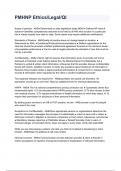Samenvatting
Extensive summary of the course Neurogenetics
- Instelling
- Universiteit Antwerpen (UA)
Extensive summary of the course Neurogenetics (2nd Master Biomedical Sciences - Neurosciences) - Examples - What to know for the exam - Illustrative pictures
[Meer zien]












